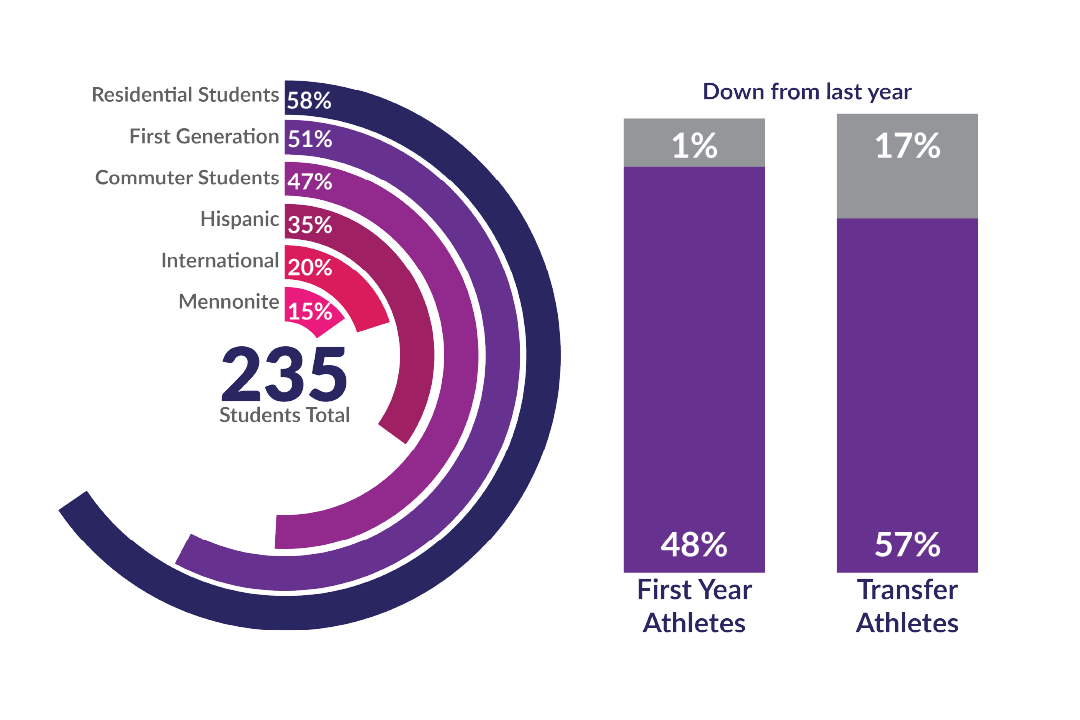The 2025-26 first-year cohort brings 188 new students to Goshen College, with an additional 47 transfer students.
Steve Wolma, vice president for enrollment management, said the main characteristics of this cohort include a higher average high school GPA and an 8% increase in the amount of people who have identified themselves as Mennonite. This has resulted in the distribution of 4% more Dean’s Academic Scholarships and double the number of Mennonites from the previous cohort.Enrollment remains high after the 2023-24 first-year cohort only brought in 156 students, the lowest number in over a decade. Since then, Wolma said, “We have worked hard to build and rebuild the new student recruitment at Goshen College over those years, and we are continuing to improve those efforts.”
Some specific strategies Wolma mentioned included bringing the work on financial aid awards and distribution in house and working directly with academics and athletics to bring enrollment numbers up.
Wolma said that he was pleased with the numbers the admissions team was able to bring in, even if they did not reach their goal of 210 first-years. He pointed out that there was not a new sports team added this year, as bowling was last year, and there are a variety of challenges surrounding recruitment in higher education.
“The fact that the admissions team scene was able to do that kind of work facing pretty strong headwinds from changes related to international student visas, the general challenges for our local Hispanic community … The admissions team really overcame quite a bit in this past cycle and they did really well,” Wolma said.
Heather Weeks, director of admissions, said that they have been making intentional changes to better serve Latino and Hispanic families since GC became a Hispanic-Serving Institution. “I think it’s a shift in thinking about our work,” Weeks said. “I would say we worked really hard these last two years to make sure that we are not just HSI by name — that it means something and that they feel it coming in.”
Weeks said that one of admission’s largest enrollment strategies is connecting with local high schools through sponsorships and promotions. “Anytime that we can get in front of students and drive them to campus, it’s always a better return on investment — so those connections are vital,” she said.
“About a year and a half ago, we started contracting with a vendor to get our name out … — digitally, branding in schools, additional banners across all of Indiana, billboards, TV spots, radio spots.” Weeks said that brand awareness has also been important as an enrollment strategy. She said that this type of promotion was not needed when GC was a predominately Mennonite institution, but is now needed as the college’s demographics have shifted.
This year also saw an increase in the number of transfer students, exceeding admissions’ goal of 45 by two. Wolma said that student athletes remain important to GC’s transfer funnel, as 57% of transfers this fall are student athletes. He also said they are still recovering from the loss of Hesston College moving from a two-year to a four-year model. “We are moving in a good direction on that,” Wolma said.
Weeks said, “This will be the second year we’ve really pushed hard into that transfer game and I’d like to think we’re seeing the return on that.” Transfer students work with Kellam Venosky, senior admissions counselor for selected populations. “He is extremely detail-oriented and a very timely individual and I think that helps the transfer student because … they can pace quickly and he’s on top of it,” Weeks said.
The 2024-25 cohort’s retention to the third semester this fall is 75%, a five year low according to Adela Hufford, director of transition, orientation and retention. Of the 49 students who did not return, Hufford said the top reasons included institutional fit, personal/family medical concerns and academic disqualification.
Another new addition this year is the dismissal of the iPad policy and implementation of a new laptop policy. The iPad policy had been in place for several years, giving all incoming undergraduate students an iPad with costs covered by tuition. The new laptop policy requires all incoming graduate students to purchase a laptop of their own that fits their schooling needs.
Paul Housholder, director of ITS and ITS media, technical and business services, said that the college is offering a payment plan option, where a laptop is supplied by the college and a student makes payments on it of $200 a semester, given to the student upon graduation.
Housholder said that in addition to the laptop itself, this payment covers the licensing and management software and anything else that happens to the laptop while the school still owns it. “If all you can do is go out and buy a used cheap laptop and it’s not really effective for your coursework or something like that — that could be an impediment to somebody’s work at GC,” Housholder said.
“The intent is to make sure that students are resourced well. … We welcome and encourage students who can purchase their own equipment and are trying to just make sure that everybody has access to the right kind of equipment — that will help faculty know that everybody has a common baseline of technology.”
Weeks said, “I think that our incoming class does look a lot different than last year’s in many ways … It’s a very high performing class.”



